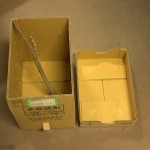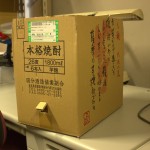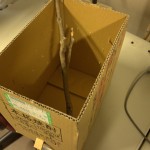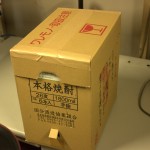Pictured is the type of swarm catching box I use when I go out to catch a swarm of honey bees.
Swarming is the way a bee colony reproduces. They basically split into two colonies–one in the original location with a new queen, and one group leaves with the old queen to find a new home. Before they leave they fill their stomachs with as much honey as they can carry. For this reason, they are usually docile and do not sting. Also since they do not have stores and brood to protect, they are normally not defensive.
About one half of the bees fly out and land on some spot they have chosen on a shrub or the branch of a tree or the wall of a building or where ever they have chosen and form a cluster there. We call that a swarm. The group of bees flying in the air to a new location is also called a swarm. They settle into a cluster and may stay there for a short time or up to several days as scout bees go out and look for a good place to start a new nest. They prefer the hollow of a tree if they can find it but will also use many other locations, such as the hollow space inside a wall, under the floor of a building, in a water meter, etc. The scout bees return to the swarm and dance on the surface, trying to convince the rest of the bees that the place they found is the best. Other bees follow them out to check on the place. When ever the swarm comes to a consensus, they take off as a group and fly to that location and enter it.
If I get a call about a swarm, I often do not know how long it has been in its current location, so I usually try and go pick it up as soon as I can. Many times I have just driven up in time to see the bees take off and fly away. That usually happened when I waited a day or two to try and go get them. Many people worry that they will stay where they are, but they won’t.
When I get there, I will open my box and put it directly under the swarm cluster as close as I can. If they are on a small branch, a firm shake will usually dislodge most of the bees and they will fall directly into the box. Hopefully the queen will be in that group that falls into the box. Otherwise I would use a bee brush to dislodge them so the cluster falls into the box. I then quickly put the lid on and place the box with the trap door open as close to where the cluster was as I can. If the queen is inside the box, bees will group around the trap door and expose their Nasanov glands, releasing a scent the remainder of bees can smell that guides them to the location where the queen is, and the bees that remained on the bush or flew into the air will gradually all go into the trap door and join the bees inside the box. You may not get 100 per cent of them, but usually it is close to all of them. If the queen is not inside the box, then all the bees that are in the box will leave the box and go cluster wherever the queen is. There have been a few times when I have had to try 3 or more times to get the queen into the box, but have usually finally succeeded. Sometimes it may take 15 minutes to 1/2 hour or longer for the remaining bees to join those in the box, even if the queen is inside.
After they are all in the box except for a very few stragglers or scouts who have just returned, then you can shut the trap door and walk away with them under your arm. Make sure you have cut some slits in the sides of the box–big enough to let air through, but small enough so bees cannot get through them. Bees have to have air and can easily overheat and then die if you do not give them enough air. It helps to transport them in a air conditioned vehicle too. A stick inside the box help give them a place to hang on and form a cluster.
When you get them home or to wherever the hive box is that you are going to install them into, take the lid off the hive box and remove a few frames to make it easier to dump them in. Jar the cardboard box on the ground hard enough to dislodge the swarm so it falls into the bottom of the box. Take the cardboard lid off, take the stick out, and dump the bees into the hive box. Carefully replace the frames you took out and put the lid back on the hive box. Then back off and leave them alone so they can get organized.
Some swarms are so large that you ought to have at least two boxes for them. If the number of bees is small enough, one box will do. The bees will usually quickly settle down and start drawing comb and the queen start laying eggs very soon. They are desperate to get the new colony going and need to raise new bees to replace the old bees that will not live very much longer. Since they have been full of honey for a while, they are in a perfect condition to convert the honey into wax that is exuded from the wax glands in their abdomens, so a swarm will usually draw out and build comb very quickly. By the afternoon of the same day or sometimes by the next morning, they have decided whether to stay or not (and they usually stay), and start flying out, orienting on their new home, and start foraging for nectar and pollen that will be needed to feed the new brood that will be hatching in a few days. It is fun and interesting to watch. You usually leave them alone for a while and do not open the hive to examine the nest until they have settled and been working for at least a couple of weeks if not longer. You should be able to tell how they are doing by watching the activity at the hive entrance without opening it. If disturbed too soon, they might decide to leave the box you put them in and go find a better place to live.
One last thing, try and not leave the swarm in the cardboard box any longer than you have to. If you leave them in overnight, they may have already started building comb on the inside lid of the box and the queen may even have started laying eggs in it. The bees inside the box will also start chewing out the air holes so they can escape the box. The box will last longer if you hive the swarm the same day you pick it up. Hopefully you already have an empty prepared hive box with frames and foundation waiting for you to put them into before you even go out to pick them up.






